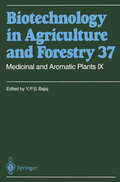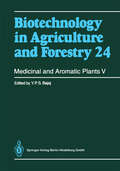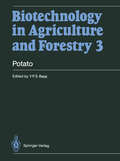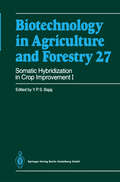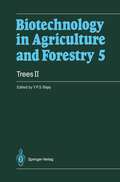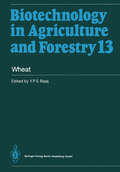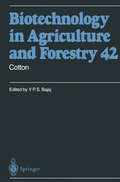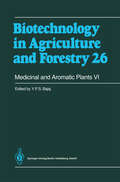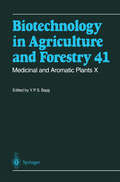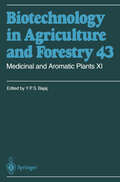- Table View
- List View
Medicinal and Aromatic Plants IX (Biotechnology in Agriculture and Forestry #37)
by Y. P. BajajThis book, Medicinal and Aromatic Plants IX, like the previous eight volumes published in 1988, 1989, 1991, 1993, 1994, and 1995, is unique in its approach. It comprises twenty-four chapters dealing with the distribution, importance, conventional propagation, micropropagation, tissue culture studies, and the in vitro production of important medicinal and pharmaceutical compounds in various species of Agave, Anthemis, Aralia, Blackstonia, Catha, Catharanthus, Cephalocereus, Clerodendron, Coronilla, Gloeophyllum, Liquidambar, Marchantia, Mentha, Onosma, Paeonia, Parthenium, Petunia, Phyllanthus, Populus, Portulaca, Sandersonia, Serratula, Scoparia, and Thapsia. It is tailored to the needs of advanced students, teachers, and research scientists in the field of pharmacy, plant tissue culture, phytochemistry, biochemical engineering, and plant biotechnology in general.
Plant Protoplasts and Genetic Engineering I (Biotechnology in Agriculture and Forestry #8)
by Y. P. BajajIsolated protoplasts are a unique tool for genetic manipulation of plants. Since the discovery of a method for the enzymatic isolation of pro-· toplasts by Professor E. C. Cocking in 1960, tremendous progress has been made in this very fascinating area of research. I have witnessed the struggle in the 1960's and early 1970's, when obtaining a clean prepara tion of protoplasts was considered an achievement. I also shared the pioneering excitement and enthusiasm in this field during the 2nd Inter national Congress of Plant Tissue Culture held at Strasbourg in 1970, where Dr. I. Thkebe of Japan presented his work on the induction of division in tobacco protoplasts. This was followed by my participation in three international conferences devoted to plant protoplasts held in 1972 in Salamanca (Spain) and Versailles (France), and then in 1975 in Nottingham (England). The enthusiasm shown by plant scientists at these meetings was ample proof of the bright future of protoplast technology, and it became evident that protoplasts would playa major role in plant biotechnology, especially in genetic engineering. Since then we have never looked back, and now the methods for isolation, fusion, and culture, as well as regeneration of somatic hybrids, have become routine laboratory procedures for most plant species. Currently the focus is on cereal and tree protoplasts. In order to bring about any genetic manipulation through fusion, in corporation of DNA, and transformation, the regeneration of the entire plant through manipulation of protoplasts is a prerequisite.
Plant Protoplasts and Genetic Engineering II (Biotechnology in Agriculture and Forestry #9)
by Y. P. BajajPlant Protoplasts and Genetic Engineering III (Biotechnology in Agriculture and Forestry #22)
by Y. P. BajajPlant Protoplasts and Genetic Engineering IV (Biotechnology in Agriculture and Forestry #23)
by Y. P. BajajPlant Protoplasts and Genetic Engineering VII (Biotechnology in Agriculture and Forestry #38)
by Y. P. BajajRice (Biotechnology in Agriculture and Forestry #14)
by Y. P. BajajRice is the most important cereal crop which feeds more than half the population of the world. It is being grown in more than 144. 641 million ha with a production of over 468. 275 million tons (in 1988). Rice is attacked by a large number of pests and diseases which cause an enormous loss in its yield. Therefore, the major objectives in rice breeding are the development of disease resistance, tolerance to insects, adverse soil water, and drought; and improvement of quality including increased protein content. Tremendous efforts being made at the International Rice Research Institute have resulted in the release of improved varieties. It is estimated that the world's annual rice production must increase from 460 million tons (in 1987) to 560 million tons by the year 2000, and to 760 million tons by 2020 (a 65% increase) in order to keep up with the population growth (IRRI Rice Facts 1988). To achieve this gigantic goal, new strategies have to be evolved. Since the success of any crop improvement program de pends on the extent of genetic variability in the base population, new techniques need to be developed not only to generate the much needed variability but also for its conservation. In this regard the progress made in the biotechnology of rice during the last 5 years has amply demonstrated the immense value of innovative approaches for further improvement of this crop.
Somaclonal Variation in Crop Improvement II (Biotechnology in Agriculture and Forestry #36)
by Y. P. BajajSomatic Embryogenesis and Synthetic Seed II (Biotechnology in Agriculture and Forestry #31)
by Y. P. BajajWhile working in the laboratory of Professor Dr. Jacob Reinert at the Freie Universitat Berlin (1974-1976), I had the opportunity to become deeply involved in studying the intricacies of the fascinating phenomenon of somatic embryogenesis in plant cells and protoplasts. In numerous stimu lating discussions with Professor Reinert on this subject, I was fully convinced that somatic embryogenesis would become one of the most important areas of study, not only regarding basic and fundamental aspects, but also for its application in crop improvement. During the last decade, we have witnessed tremendous interest and achievements in the use of somatic embryos for the production of synthetic seeds, for micro prop a gation, genetic transformation, cryopreservation, and conservation of germplasm. The en masse production of somatic embryos in the bioreactors has facilitated some of these studies. Somatic embryos have now been induced in more than 300 plant species belonging to a wide range offamilies. It was therefore felt that a compilation ofliterature/state of the art on this subject was necessary. Thus, two volumes on Somatic Embryo genesis and Synthetic Seed have been compiled, which contain 65 chapters contributed by International experts. Somatic Embryogenesis and Synthetic Seed I comprises 31 chapters, arranged in 3 sections: Section I Commitment of the cell to somatic embryogenesis; early events; anatomy; molecular basis; gene expression; role of polyamines; machine vision analysis of somatic embryos. Section II Applications of somatic embryos; technology of synthetic seed; fluid drilling; micropropagation; genetic transfor mation through somatic embryos; cryopreservation.
Somatic Hybridization in Crop Improvement I (Biotechnology in Agriculture and Forestry #27)
by Y. P. BajajTrees I (Biotechnology in Agriculture and Forestry #1)
by Y. P. BajajBiotechnology has come to a stage where, by replacing some of the age old practices of breeding, it can produce novel and improved plants and animals that can better serve human beings and their purposes. The techniques of cellular and subcellular engineering, such as gene splicing and recombinant DNA, cloning, hybridomas and monoclonal anti bodies, production of human insulin, protein engineering, industrial fermentation, artificial insemination, cryopreservation and ovum trans fer, plant tissue culture and somatic hybridization, nitrogen fixation, phytomass production for biofuels etc have advanced greatly in the past decade, due to the availability of better equipment and the consolida tion of knowledge. Product orientation has removed biotechnology from the area of pure academic interest to one of utility where the final product is a spur to action. Businesses have started pouring money into projects, which has aided greatly in improving equipment, information exchange, and arousing the interest and imagination of the public. The common goal of science, industry and the public opens wide vistas and great hopes for biotechnology. The business of biotechnology addresses itself to issues of factory farming, technology transfer, joint ventures, international cooperation and to specific topics as well as the produc tion of diagnostic kits. Industry is particularly concerned with the phar maceutical field and microbial biotechnology from which profitable return§ can accrue. Commercial interests have led to better management practices and systematisation.
Trees II (Biotechnology in Agriculture and Forestry #5)
by Y. P. Bajaj'frees contribute a major part of fuel, fodder and fruit, and are an im of bioenergy. They are now needed in large numbers more portant source than ever before for afforestation and social forestry, so that fast-grow ing and multipurpose trees assume great importance. After extensive in discriminate deforestation and rapid depletion of genetic stocks, efforts are now being made to evolve methods for clonal mass propagation of improved and elite trees. Production of short-duration trees with a rapid turnover of biomass, and induction of genetic variability through in vitro manipulation for the production of novel fruit and forest trees, which are high-yielding and resistant to pests and diseases, and trees which display increased photosynthetic efficiency are in demand. These objectives are well within the realm of horticultural and forest biotech nology. Some of the recent advances, such as the regeneration of com plete trees from isolated protoplasts, somatic hybridization, and the Agrobacterium-mediated transformation in various tree species have opened new vistas for the genetic engineering of fruit and forest trees. This book is a continuation of the earlier volume Trees I, and presents 31 chapters on fruit, forest, nut and ornamental trees, such as avocado, pineapple, crabapple, quince, pistachio, walnut, hazelnut, date palm, oil palm, cacao, rubber, maple, sweet-gum, poplars, birches, Chinese tallow, willows, oaks, paper mulberry, rhododendrons, Scots pine, Calabrian pine, Douglas-fir, redwood, ginkgo, cycads and some flowering trees.
Trees III (Biotechnology in Agriculture and Forestry #16)
by Y. P. BajajAfter the 1986 and 1989 volumes, this is the third volume on biotechnology for propagation of trees. Comprising 28 chapters contributed by international experts the book deals with fruit, ornamental, and forest trees, such as Black cherry, Sour cherry, Pomegranate, Loquat, Ficus, Yellow poplar, Horse chestnut, Judas tree, Linden tree, Saskatoons, Taiwan sassafras, Plane-tree, Rattans, Bamboos, Engelmann spruce, White spruce, Larches, Hinoki cypress, Western redcedar, and various types of pines, i.e. Jack, Carribean, Eldarica, Slash, Egg-cone, Maritime, Ponderosa, Eastern white, Loblolly pine. Trees III is an excellent reference book for scientists, educators, and students of forestry, botany, genetics, and horticulture, who are interested in tree biotechnology.
Wheat (Biotechnology in Agriculture and Forestry #13)
by Y. P. BajajWheat, which is the second most important cereal crop in the world, is being grown in a wide range of climates over an area of about 228 945 thou sand ha with a production of about 535 842 MT in the world. Bread wheat (Triticum aestivum L. ) accounts for 80% of the wheat consumption, howe ver, it is attacked by a large number of pests and pathogens; rusts and smuts cause enormous damage to the crop and reduce the yield drastically in some areas. The major breeding objectives for wheat include grain yield, earliness, resistance to lodging and diseases, spikelet fertility, cold tolerance, leaf duration and net assimilation rate, fertilizer utilization, coleoptile length, nutritional value, organoleptic qualities, and the improvement of charac ters such as color and milling yield. The breeding of wheat by traditional methods has been practiced for centuries, however, it has only now come to a stage where these methods are insufficient to make any further breakthrough or to cope with the world's demand. Although numerous varieties are released every year around the world, they do not last long, and long-term objectives cannot be realized unless more genetic variability is generated. Moreover, the intro duction of exotic genetic stocks and their cultivation over large areas results in the depletion and loss of the native germplasm pool.
Cotton (Biotechnology in Agriculture and Forestry #42)
by Y. P. S. BajajCotton is a multipurpose crop and produces lint, the most important source of fiber used in the textile industry, oil, seed meal, and hulls.Twenty-three chapters on various aspects of in vitro manipulation and other biotechnological approaches to the improvement of cotton are arranged in six sections. Special emphasis is placed on interspecific hybridization, somaclonal variation, transgenic cotton resistant to insects and herbicides, and re-engineering of fiber. This book is of special interest to advanced students, teachers, and research workers in the field of cotton breeding, genetics, tissue culture, molecular biology, and plant biotechnology in general.
